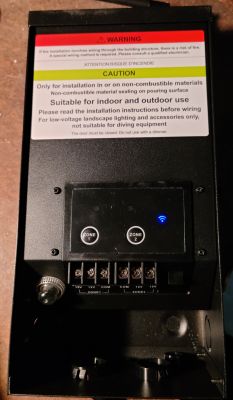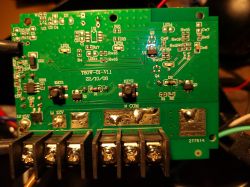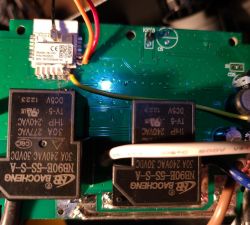Ok, I tried again and was successful flashing with the GUI flasher. (Either I did something wrong, or the device didn't want to boot up when connected to 3.3V from a lab power supply after flashing. But it started fine when I plugged it into mains again.) Detailed description to follow.
Added after 32 [minutes]:


It's easy to open the case and access the mainboard, taking care not to damage the antenna cable that runs from the antenna at the top of the enclosure. It can be disconnected by prying it off.
To flash, I soldered wires to the module's pin 14 (3V3), 15 (TX1), 16 (RX1), and GND by soldering a header pin to one of the unpopulated through-holes at KEY3. I could also have soldered pin 18 (CEN) for good measure since it's needed for flashing, but ended up just touching a wire to the pad.
The SoC pins are connected as follows:
| P6 | WiFi LED (inverted) |
| P7 | Zone 1 button |
| P8 | Zone 2 button |
| P24 | Zone 1 relay and LED |
| P26 | Zone 2 relay and LED |
And the config:
{
"vendor": "Suraielec",
"bDetailed": "0",
"name": "Low Voltage 200W Smart Wi-Fi Transformer",
"model": "ULTW20B",
"chip": "BK7231N",
"board": "N/A",
"flags": "0",
"keywords": [
"landscape",
"transformer",
"led"
],
"pins": {
"6": "WifiLED_n;3",
"7": "Btn;1",
"8": "Btn;2",
"24": "Rel;1",
"26": "Rel;2"
},
"command": "",
"image": "https://obrazki.elektroda.pl/2257367400_1697425459.jpg",
"wiki": "https://www.elektroda.com/rtvforum/viewtopic.php?p=20772013"
}









